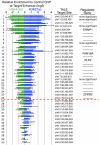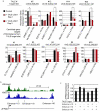Locus-specific editing of histone modifications at endogenous enhancers
- PMID: 24013198
- PMCID: PMC3858395
- DOI: 10.1038/nbt.2701
Locus-specific editing of histone modifications at endogenous enhancers
Abstract
Mammalian gene regulation is dependent on tissue-specific enhancers that can act across large distances to influence transcriptional activity. Mapping experiments have identified hundreds of thousands of putative enhancers whose functionality is supported by cell type-specific chromatin signatures and striking enrichments for disease-associated sequence variants. However, these studies did not address the in vivo functions of the putative elements or their chromatin states and did not determine which genes, if any, a given enhancer regulates. Here we present a strategy to investigate endogenous regulatory elements by selectively altering their chromatin state using programmable reagents. Transcription activator-like (TAL) effector repeat domains fused to the LSD1 histone demethylase efficiently remove enhancer-associated chromatin modifications from target loci, without affecting control regions. We find that inactivation of enhancer chromatin by these fusion proteins frequently causes downregulation of proximal genes, revealing enhancer target genes. Our study demonstrates the potential of epigenome editing tools to characterize an important class of functional genomic elements.
Figures



Comment in
-
Gene regulation: Chromatin editing reveals enhancer targets.Nat Rev Genet. 2013 Nov;14(11):749. doi: 10.1038/nrg3601. Epub 2013 Sep 24. Nat Rev Genet. 2013. PMID: 24061147 No abstract available.
-
Epigenome editing.Nat Biotechnol. 2013 Dec;31(12):1097-9. doi: 10.1038/nbt.2756. Nat Biotechnol. 2013. PMID: 24316647 No abstract available.
-
Modifying chromatin to shut off enhancers.Nat Methods. 2013 Nov;10(11):1052-3. doi: 10.1038/nmeth.2717. Nat Methods. 2013. PMID: 24344380 No abstract available.
References
-
- Noonan JP, McCallion AS. Genomics of long-range regulatory elements. Annu Rev Genomics Hum Genet. 2010;11:1–23. - PubMed
Publication types
MeSH terms
Substances
Associated data
- Actions
Grants and funding
LinkOut - more resources
Full Text Sources
Other Literature Sources
Molecular Biology Databases
Research Materials
Miscellaneous

